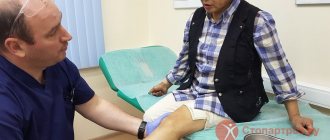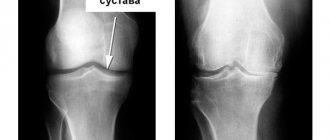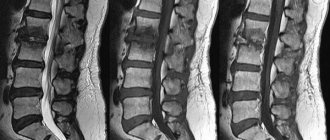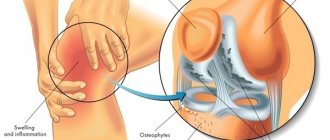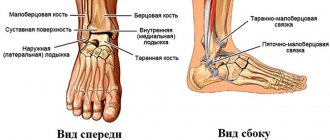Pain in the foot is the most common among the pathological conditions of the musculoskeletal system between the ages of 20 and 50, accompanied by pain. We can conclude that it is the able-bodied part of the population that suffers, since the legs bear a considerable load, and the foot does not always withstand intensive sports and injuries painlessly and without consequences. I identify a group of reasons for which the leg hurts at the bend of the foot, and the reasons are not always associated with diseases of the joints; pain in the ankle, including the bend of the foot, can be due to pathologies of blood vessels, muscles, and compression of nerve endings. Sometimes pain in the feet is a consequence of a problematic spine or systemic diseases occurring in the body.
In total, there are 26 bones of various sizes in the structure of the foot, but in the area of interest to us - on the bend, the ankle joint (larger and fibula, talus), calcaneus, navicular bone and the metatarsal-tarsal area can hurt. All these bones and the ankle joint are surrounded by a muscular-ligamentous apparatus that protects against injury, especially dislocations and fractures in the ankle. By the way, it is worth noting that women are much more susceptible to pain in this area, since they tend to sacrifice health for the sake of beauty and image. Let's look at the main reasons that lead to the feeling of pain in the bend of the foot.
Bursitis of the feet
Bursitis is considered a common disease associated with inflammation of the joint capsule in our version in the area of the foot, that is, the ankle joint. The joint capsule has several important functions:
- protection of the joint from mechanical influences;
- nutrition of articular cartilage with synovial fluid.
Bursitis of the foot is most often caused by trauma, and this may not necessarily be a fracture; sometimes a simple dislocation or bruise is enough to cause inflammation of the joint capsule. Bursitis is provoked by frequent twisting of the foot, which is familiar to almost every person. A person’s lifestyle affects the health of the joint, so obesity and excessive stress on the feet increase the risk of developing pathology. Often, women after childbirth, with impaired metabolism and hormonal imbalances, gain excess weight, which also provokes bursitis.
Athletes and people in working professions exposed to stress on their legs and vibrations are susceptible to bursitis. A common cause of bunions is wearing high-heeled shoes. The disease is caused by ongoing rheumatism, gout, and psoriasis.
Symptoms of bursitis begin with pain in the ankle joint; over time, the pain spreads to the area of the heel tubercle, to the toes, that is, the bend of the foot is directly affected.
In addition to pain, the foot may swell and become painful on palpation. The mobility of the joint is sharply limited, and hyperemia of the skin is observed. Over time, the joint can become very swollen, and an accumulation of exudate forms in the joint cavity - this is accompanied not only by pain, but also by an increase in body temperature, causing the person to panic. When a suppurative process appears in the joint, the phenomenon of fluctuation is observed, that is, fluid fluctuations during palpation.
To treat bursitis, especially when the joint hurts severely, a course of NSAID drugs is prescribed. Most often, doctors' choice falls on Diclofenac (Voltaren), Nimesulide and Ibuprofen. In addition to taking tablets or injections, anti-inflammatory ointments are prescribed - Fastum-gel, Dolgit cream, Finalgon. If the pain does not go away, then a hormonal drug is prescribed that relieves inflammation - a blockade is done with Diprospan, Kenalog.
The course of treatment for bursitis includes physiotherapy, gymnastics, and massage. In case of a suppurative process, puncture and antibiotic therapy are necessary. During the recovery period, paraffin treatment and mud therapy help. In advanced cases, it is necessary to resort to the procedure of dissecting the joint capsule, as the threat of Achilles tendon rupture increases.
Localization of pain in the foot
If it hurts to step on your foot, then to find out the cause of this symptom, you need to determine exactly where the pain originates. Most often, the patient determines the location of the pain:
- fingers;
- sole;
- heel;
- localization is not determined.
Pain in the forefoot indicates an ingrown toenail, hallux valgus, or sesamoiditis. If it hurts to step on the foot in the heel area, then perhaps the cause is the formation of a heel spur or inflammation of the Achilles tendon.
Orthopedic doctor Andrey Sergeevich Litvinenko comments:
Plantar pain may indicate the presence of fasciitis or metatarsalgia. If your foot hurts for no reason and it is difficult to determine its location, then it is likely that we are talking about some degenerative changes in tendons or soft tissues, flat feet, tendinitis, or arthritis.
Arthritis
Due to increased physical activity and load in the form of human body weight, the ankle joint and foot bones are susceptible to arthritis. The disease is associated with an inflammatory process in the joint itself, and inflammation is most often caused by other serious pathologies. So, we can identify the main causes of ankle arthritis:
- systemic lupus;
- Bekhterev's disease;
- rheumatoid arthritis.
In addition to these reasons, arthritis is an age-related disease, along with osteoporosis, arthrosis, which occurs due to excessive stress, lack of vitamins and minerals. Pathology often occurs in diabetes mellitus, as a result of injuries, in athletes. There are cases when the disease develops during alcoholism, drug addiction, after childbirth, and menopause. Arthritis also affects women more often, for the same reason as bursitis.
Let's look at what symptoms predominate in arthritis and how to relieve them. First of all, emphasis is placed on the fact that arthritis can be acute, with a sudden onset of the disease with severe pain, limited joint movement, and in a chronic form.
In the chronic form, arthritis manifests itself in periods of remission, when symptoms are not observed; this form is mainly observed in rheumatism. But during an exacerbation the symptoms increase.
With arthritis, there is a feeling of morning stiffness, that is, the symptoms of pain most clearly manifest themselves during the period when a person begins to get out of bed. When he walks around, the symptoms subside. The feet often hurt symmetrically, which is characteristic of rheumatism. The ankle may be swollen and painful on palpation, which requires immediate treatment.
As the disease progresses, pain is felt not only in the bend of the foot and the ankle itself, but also higher up the leg. Muscle atrophy appears, causing a person’s performance to decrease, even to the point of disability. Inflammation can cause an increase in body temperature and a deterioration in overall health.
With arthritis, diagnosis is important, since if the cause of the pathology is rheumatism, then conventional treatment of the joints will not help. For rheumatism, special medications and hormones are prescribed. If a suppurative process develops in the joint, then antibiotic therapy is added to the treatment. A course of NSAIDs, physiotherapy, and folk remedies will help relieve pain. Arthritis should be treated by a doctor. During the rehabilitation period, vitamins, chondroprotectors, and sanatorium treatment are prescribed.
Methods for diagnosing disorders
High-quality diagnosis is the key to correct and effective treatment. With the help of diagnostic measures, you can understand what exactly caused the pain and how to deal with this disorder.
If you have pain in the middle of the sole and you don’t know which doctor to see, first contact a general practitioner (this is a general practitioner who, after examining him, will be able to refer the patient to a specialist).
Diagnosis of the cause of pain in the middle occurs in several stages. The first is an initial medical examination. During it, the doctor pays attention to the following important points:
Advertising:
- foot architecture (is there any deformation of the toes, flat feet and other structural abnormalities);
- elasticity of the sole;
- presence of swollen surfaces;
- range of motion of the foot joints (both metatarsal joints and ankles are checked);
- the presence of redness or other changes on the skin.
Also, many doctors ask the patient to walk around during the appointment. Using this technique, you can assess the nature of the gait and even (not always, but in some cases) make a primary diagnosis.
Nausea and vomiting make any person unable to work, both men and women. Such symptoms have a negative impact on health and impair quality of life. Read more in the article: “stomach pain and nausea: causes and treatment.”
After the initial examination, the patient is necessarily referred for instrumental studies. With their help, you can study the clinical picture more deeply and examine the condition of the tissues and bones of the foot from the inside. The list of common instrumental studies includes:
- Radiography
. During this procedure, a photograph of the foot is taken in two projections. The resulting images show whether there is deformation of the bones and joints and how severe it is. - Ultrasound
. This instrumental study allows you to analyze the condition of soft tissues and understand whether there are pinches, inflammation, compactions and other violations of their structure. - Tomography
. The most informative type of study, which combines both x-ray and ultrasound. - Foot cast
. Allows you to determine the presence of curvatures of the foot, including flat feet.
If the doctor needs more detailed information on the patient’s condition (typical for cases with extensive damage to bones and joints, obesity, and some other disorders), he may prescribe a number of additional tests. Usually this is a general and biochemical urine/blood test.
Advertising:
If the doctor suspects an intra-articular inflammatory process, he can take synovial fluid for analysis. It is removed by piercing the joint with a long needle, the procedure is done under local anesthesia.
Flat feet
Pain in the arch of the foot is often caused by flat feet, a disease characterized by flattening of the arches of the feet. There are longitudinal and transverse types of flatfoot, each of which has its own characteristics in symptoms.
Pain is inherent in each type of flatfoot, only with the transverse type the anterior part hurts, there is a curvature of the 1st toe, the formation of a bump, and the foot itself becomes wider. The longitudinal type of flatfoot is characterized by elongation of the foot, frequent formation of heel spurs, plantar fasciitis, pain in the heel and in the center of the foot. Despite this, pain in the bend of the foot can occur with any type of flatfoot.
Flat feet are caused by excessive stress on the legs, wearing narrow shoes or high heels, which is why women suffer from the pathology several times more often. Very often, the disease occurs due to excessive stress on the feet of young children in combination with wearing uncomfortable shoes. Flat feet are caused by injuries when a girl twists her leg or breaks it, obesity, condition after childbirth, with weakness of the musculoskeletal system, with diabetes.
By the way, flat feet are often caused by bursitis, arthrosis, and arthritis of the joints of the feet. Pathology is characterized by stage 3 of development. In the initial stage, pain in the foot rarely occurs; there is mainly discomfort and fatigue after putting pressure on the legs. As the pain progresses, the pain begins to appear more often, the shape of the foot changes, and patients often complain that it becomes difficult for them to take off or put on their shoes. In advanced stages, pain also occurs at rest, a person’s gait is disturbed, and other joints and spine begin to ache.
Treatment of flat feet consists of using orthopedic shoes or insoles instead of conventional shoes, which are selected individually, depending on the type of flat feet. The doctor must select a course of exercise therapy and prescribe physiotherapy and massage procedures. Surgery is rarely performed. Pain-relieving drugs are Ibuprofen, Diclofenac, Movalis, Nimesulide, which can be prescribed by a doctor during an exacerbation.
Other reasons
Often the bend of the foot hurts not at all from various diseases, but from banal overwork. Pain in the foot is often observed after wearing high-heeled shoes, when you have to stand still for many hours or walk without rest. Such symptoms are common in athletes, teachers, salespeople and similar professions.
Often a person has a question about why the bend of the foot hurts, but no injuries or inflammation are observed. The cause of this condition may be edema that appears due to vascular diseases (varicose veins), kidney disease, diabetes mellitus and a number of other diseases. Edema occurs when drinking large amounts of water, salted fish, and alcoholic edema often occurs, which a person feels the next day.
In case of vascular diseases, it is better not to delay contacting a doctor, since such pathologies progress quickly and as a result, the limb may become numb and lose weight. A modern vascular surgeon and phlebologist can select effective treatment for most pathologies.
The bend of the foot hurts after injury, especially when a girl or woman twisted her ankle or a heavy object fell on her feet. The fact is that the metatarsal bones are small and can move and put pressure on nerves and blood vessels. Often, legs hurt during pregnancy and after childbirth, as a woman experiences the stress associated with bearing a fetus, and subsequently feeding it. After childbirth, hormonal levels and metabolism are often disrupted, which is why pathologies of the musculoskeletal system worsen.
There are also rare pathologies that lead to pain in the bend of the foot. These can be neoplasms (cysts), myositis, neuritis, and the treatment of each pathology requires an individual approach. Tibialis tendonitis, which occurs after injuries, overloads of muscles and ligaments, causes ankle pain syndrome.
If pain begins to appear in the bend of the foot, intensifying over time and not going away within several days, then it is better not to delay going to the doctor and not to self-medicate. Timely treatment in the early stages will take less effort and time.
Treatment
Any discomfort in the feet, even if they appear infrequently and pass quickly, requires special treatment or lifestyle changes. When your feet hurt in the morning not due to pathological processes, you can prevent this condition by choosing only comfortable shoes with small heels and using orthopedic insoles or inserts. It is necessary to strengthen muscles and ligaments by performing special exercises. It is also recommended to monitor your weight so that your feet are not subjected to increased stress. Proper nutrition is important, providing the body with all the necessary microelements.
In the evening, after increased stress, it is recommended to make a contrasting foot bath with sea salt or herbal decoctions. Then lie down and raise your legs to an elevated position. Massage also helps prevent morning pain. You can use ointments with warming and relaxing properties for it.
To prevent morning pain, it is recommended to take a relaxing foot bath in the evening after increased stress.
If this condition is associated with chronic diseases, special treatment is necessary. It takes place under the guidance of specialists. Most often this is a traumatologist, orthopedist, surgeon, phlebologist or neurologist. After examining and determining the cause of the pain, the doctor prescribes special therapy. You can get rid of such sensations only when the inflammation is eliminated and blood circulation in the extremities is restored. Treatment of such pathologies must be comprehensive. It is often long lasting or even permanent.
The main therapeutic methods are medication. Most often these are anti-inflammatory, painkillers, drugs to improve blood circulation and metabolic processes, and multivitamins. The use of external agents is also effective. These are ointments and gels with analgesic, anti-inflammatory, warming and relaxing effects.
Additionally, pathologies that cause pain in the feet in the morning can be treated using physiotherapeutic methods. This can be electrophoresis, shock wave therapy, magnetic therapy, paraffin baths. Physical therapy and massage are effective for any pathology. And with increased loads, it is recommended to use orthopedic devices.
At home, you can use traditional methods. They are especially effective for plantar fasciitis. Folk remedies help relieve inflammation and reduce pain.
The most commonly used recipes are:
- a compress of cabbage leaves smeared with honey at night;
- lotion from a mixture of lard, raw egg, vinegar and honey;
- A compress of salt, honey and iodine is effective; you can keep it for no more than 15 minutes;
- Tie a fresh burdock leaf to the sole for the whole day.

